Simultaneous Free Flow and Forcefully Driven Movement of Magma in Lamprophyre Dykes as Indicated by Magnetic Anisotropy: Case Study from the Central Bohemian Dyke Swarm, Czech Republic
Abstract
:1. Introduction
2. Concise Geological Setting
3. Sampling, Technique of Measurement, Data Presentation
4. Petrology and Bulk Rock Chemistry
5. Magnetic Mineralogy
6. Magnetic Fabric
6.1. Standard Anisotropy of Magnetic Susceptibility (AMS)
6.2. Anisotropy of Anhysteretic Magnetic Remanence (AAMR) and Anisotropy of Out-of-Phase Magnetic Susceptibility (opAMS)
7. Discussion
7.1. Variation of Mineral Textures and AMS Fabrics across the Composite Dyke
7.2. Implications of AMS Fabrics to Multistage Evolution of Magmatic Dykes
8. Conclusions
Author Contributions
Funding
Acknowledgments
Conflicts of Interest
References
- Silva, P.F.; Marques, F.O.; Henry, B.; Madureira, P.; Hirt, A.M.; Font, E.; Lourenco, N. Thick dyke emplacement and internal flow: A structural and magnetic fabric study of the deep-seated dolerite dyke on Foum Zguid (Southern Morocco). J. Geophys. Res. 2010, 115, B12109. [Google Scholar] [CrossRef]
- Correa-Gomes, L.C.; Souza Filho, C.R.; Martins, C.J.F.N.; Oliveira, E.P. Development of symmetrical and asymmetrical fabrics in sheet-like igenous bodies: The role of magma flow and wall-rock displacements in theoretical and natural cases. J. Struct. Geol. 2001, 23, 1415–1428. [Google Scholar] [CrossRef]
- Skarmeta, J. Interaction between magmatic and tectonic stresses during dyke intrusion. And. Geo. 2011, 38, 393–413. [Google Scholar] [CrossRef]
- Callot, J.-P.; Geoffroy, L.; Aubourg, C.; Pozzi, J.P.; Mege, D. Magma flow directions of shallow dykes from the East Greenland volcanic margin inferred from magnetic fabric studies. Tectonophysics 2001, 335, 3–4. [Google Scholar] [CrossRef]
- Clemente, C.S.; Amoros, E.B.; Crespo, M.G. Dike intrusion under shear stress: Effects on magnetic and vesicle fabrics in dikes from rift zones of Tenerife Canary Islands). J. Struct. Geol. 2007, 29, 1931–1942. [Google Scholar] [CrossRef]
- Ernst, R.E.; Baragar, W.R.A. Evidence from magnetic fabric for the flow pattern of magma in the Mackenzie giant radiating dyke swarm. Nature 1992, 356, 511–513. [Google Scholar] [CrossRef]
- Féménias, O.; Diot, H.; Brza, T.; Gauffriau, A.; Demaiffe, D. Assymetrical to symmetrical magnetic fabric of dikes: Paleo-flow orientations and Paleo-stresses recorded on feeder-bodies from the Motru Dike Swarm (Romania). J. Struct. Geol. 2004, 26, 1401–1418. [Google Scholar] [CrossRef]
- Hrouda, F.; Verner, K.; Kubínová, Š.; Buriánek, D.; Faryad, S.W.; Chlupáčová, M.; Holub, F.V. Magnetic fabric and emplacement of dykes of lamprophyres and related rocks of the Central Bohemian Dyke Swarm (Central European Variscides). J. Geosci. 2016, 61, 335–354. [Google Scholar] [CrossRef]
- Knight, M.D.; Walker, G.P.L. Magma flow directions in dykes of the Koolan Complex, Oahu, determined from magnetic fabric studies. J. Geophys. Res. 1988, 93, 4308–4319. [Google Scholar] [CrossRef]
- Raposo, M.I.B. Magnetic Fabric of the Brazilian Dike Swarms: A Review. In The Earth’s Magnetic Interior; IAGA Special Sopron Book Series 1; Petrovský, E., Herroro-Bervera, E., Harinarayana, T., Ivers, D., Eds.; IAGA: Hong Kong, China, 2011; pp. 247–262. [Google Scholar]
- Raposo, M.I.B.; Ernesto, M. Anisotropy of magnetic susceptibility in the Ponta Grossa dyke swarm (Brazil) and its relationship with magma flow direction. Phys. Earth Planet. Int. 1995, 87, 183–196. [Google Scholar] [CrossRef]
- Rochette, P.; Jenatton, L.; Dupuy, C.; Boudier, F.; Reuber, I. Diabase dykes emplacement in the Oman ophiolite: A magnetic fabric study with reference to geochemistry. In Ophiolite Genesis and Evolution of the Oceanic Lithosphere; Peters, T., Nicolas, A., Coleman, R., Eds.; Springer: Dordrecht, The Netherlands, 1991; pp. 55–82. [Google Scholar]
- Staudigel, H.; Gee, J.; Tauxe, L.; Varga, R.J. Shallow intrusive directions of sheeted dykes in the Troodos ophiolite: Anisotropy of magnetic susceptibility and structural data. Geology 1992, 20, 841–844. [Google Scholar] [CrossRef]
- Varga, R.J.; Gee, J.S.; Staudigel, H.; Tauxe, L. Dike surface lineations as magmaflow indicators within the sheeted dike complex of the Troodos ophiolite, Cyprus. J. Geophys. Res. 1998, 103, 5241–5256. [Google Scholar] [CrossRef]
- Bates, M.P.; Mushayandebvu, M.F. Magnetic fabric in the Umvimeela Dyke, satelite of the Great Dyke, Zimbabwe. Tectonophysics 1995, 242, 141–254. [Google Scholar] [CrossRef]
- Park, J.K.; Tanczyk, E.I.; Desbarats, A. Magnetic fabric and its significance in the 1400 Ma Mealy diabase dykes of Labrador, Canada. J. Geophs. Res. 1988, 93, 13689–13704. [Google Scholar] [CrossRef]
- Stephenson, A.; Sadikum, S.; Potter, D.K. A theoretical and experimental comparison of the anisotropies of magnetic susceptibility and remanence in rocks and minerals. Geophys. J. Astron. Soc. 1986, 84, 185–200. [Google Scholar] [CrossRef] [Green Version]
- Hrouda, F. The magnetic fabric in the Brno massif. Sbor. Geol. Věd. 1985, 19, 89–112. [Google Scholar]
- Holub, F.V.; Verner, K.; Schmitz, M.D. Temporal relations of melagranite porphyry dikes and durbachitic plutons in South Bohemia. Geos. Res. Rep. 2011, 2012, 23–25. [Google Scholar]
- Machek, M.; Roxerová, Z.; Závada, P.; Silva, P.F.; Henry, B.; Dědeček, P.; Petrovský, E.; Marques, F.O. Intrusion of lamprophyre dyke and related deformation effects in the host rock salt: A case study from the Loule diapir, Portugal. Tectonophys 2014, 629, 165–178. [Google Scholar] [CrossRef]
- Chalapathi Rao, N.V.; Srivastava, R.K. Kimberlites, lamproites, lamprophyres, their entrained xenoliths, mafic dykes and dyke swarms: Highlights of Recent Indian Research. Proc. Indian natn. Sci. Acad. 2012, 78, 431–444. [Google Scholar]
- Edgar, A.D.; Mitchell, R.H. Ultra high pressure–temperature melting experiments on an SiO2-rich lamproite from Smoky Butte, Montana: Derivation of siliceous lamproite magmas from enriched sources deep in the continental mantle. J. Petrol. 1997, 38, 457–477. [Google Scholar] [CrossRef]
- Guo, Z.; Wilson, M.; Liu, J.; Mao, Q. Post-collisional, potassic and ultrapotassic magmatism of the northern Tibetan Plateau: Constraints on characteristics of the mantle source, geodynamic setting and uplift mechanisms. J. Petrol. 2006, 47, 1177–1220. [Google Scholar] [CrossRef]
- Gupta, A.K. Origin of Potassium-Rich Silica-Deficient Igneous Rocks; Springer: Berlin, Germany; New York, NY, USA, 2015. [Google Scholar]
- Holub, F. Zonal dyke of ocelli lamprophyre to hornblendite from Dobříš. Zprávy Geol. Výzk. 2003, 2003, 106–108. (In Czech) [Google Scholar]
- Dörr, W.; Zulauf, G. Elevator tectonics and orogenic collapse of a Tibetan-style plateau in the European Variscides: The role of the Bohemian shear zone. Int. J. Earth Sci. 2010, 99, 299–325. [Google Scholar] [CrossRef]
- Faryad, S.W.; Jedlička, R.; Collett, S. Eclogite facies rocks of the Monotonous unit, clue to Variscan suture in the Moldanubian Zone (Bohemian Massif). Lithos 2013, 179, 353–363. [Google Scholar] [CrossRef]
- Schulmann, K.; Konopásek, J.; Janoušek, V.; Lexa, O.; Lardeaux, J.M.; Edel, J.B.; Štípská, P.; Ulrich, S. An Andean type Palaeozoic convergence in the Bohemian Massif. Comptes Rendus Geosci. 2009, 341, 266–286. [Google Scholar] [CrossRef]
- Žák, J.; Verner, K.; Finger, F.; Faryad, S.W.; Chlupáčová, M.; Veselovský, F. The generation of voluminous S-type granites in the Moldanubian unit, Bohemian Massif, by rapid isothermal exhumation of the metapelitic middle crust. Lithos 2011, 121, 25–40. [Google Scholar] [CrossRef]
- Žák, J.; Verner, K.; Janoušek, V.; Holub, F.V.; Kachlík, V.; Finger, F.; Hajná, J.; Tomek, F.; Vondrovic, L.; Trubač, J. A plate–kinematic model for the assembly of the Bohemian Massif constrained by structural relationships around granitoid plutons. In The Variscan Orogeny: Extent, Timescale and the Formation of the European Crust; Special Publications 405; Schulmann, K., Martínez Catalán, J.R., Lardeaux, J.M., Janoušek, V., Oggiano, G., Eds.; Geological Society: London, UK, 2014; pp. 169–196. [Google Scholar]
- Jedlička, R.; Faryad, S.W.; Hauzenberger, C. Prograde metamorphic history of UHP granulites from the Moldanubian Zone (Bohemian Massif) revealed by major element and Y + REE zoning in garnets. J. Petrol. 2015, 56, 2069–2088. [Google Scholar] [CrossRef]
- Finger, F.; Roberts, M.P.; Haunschmid, B.; Schermaier, A.; Steyrer, H.P. Variscan granitoids of central Europe: Their typology, potential sources and tectonothermal relations. Miner. Petrol. 1997, 61, 67–96. [Google Scholar] [CrossRef]
- Holub, F.V.; Klečka, M.; Matějka, D. Igneous activity. In Pre-Permian Geology of Central and Eastern Europe; Dallmeyer, R.D., Franke, W., Weber, K., Eds.; Springer: Berlin, Germany, 1995; pp. 444–452. [Google Scholar]
- Janoušek, V.; Braithwaite, C.J.R.; Bowes, D.R.; Gerdes, A. Magma-mixing in the genesis of Hercynian calc-alkaline granitoids: An integrated petrographic and geochemical study of the Sázava intrusion, Central Bohemian Pluton, Czech Republic. Lithos 2004, 78, 67–99. [Google Scholar] [CrossRef]
- Schaltegger, U. Magma pulses in the Central Variscan Belt: Episodic melt generation and emplacement during lithospheric thinning. Terra Nova 1997, 9, 242–245. [Google Scholar] [CrossRef]
- Janoušek, V.; Gerdes, A. Timing the magmatic activity within the Central Bohemian Pluton, Czech Republic: Conventional U-Pb ages for the Sázava and Tábor intrusions and their geotectonic significance. J. Geosci. 2003, 48, 70–71. [Google Scholar]
- Janoušek, V.; Wiegand, B.; Žák, J. Dating the onset of Variscan crustal exhumation in the core of the Bohemian Massif: New U–Pb single zircon ages from the high-K calcalkaline granodiorites of the Blatná suite, Central Bohemian Plutonic Complex. J. Geol. Soc. 2010, 167, 347–360. [Google Scholar]
- Kubínová, Š.; Faryad, S.W.; Verner, K.; Schmitz, M.; Holub, F.V. Ultrapotassic dykes in the Moldanubian Zone and their significance for understanding post-collisional mantle dynamics during the Variscan orogeny in the Bohemian Massif. Lithos 2017, 272, 205–221. [Google Scholar] [CrossRef]
- Ackerman, L.; Pašava, J.; Erban, V. Re-Os geochemistry and geochronology of the Ransko gabbro-peridotite massif, Bohemian Massif. Miner. Depos. 2013, 48, 799–804. [Google Scholar] [CrossRef]
- Faryad, S.W.; Kachlík, V.; Sláma, J.; Hoinkes, G. Implication of corona formation in a metatroctolite to the granulite facies overprint of HP-UHP rocks in the Moldanubian Zone (Bohemian Massif). J. Metamorph. Geol. 2015, 33, 295–310. [Google Scholar] [CrossRef]
- Faryad, S.W.; Kachlík, V.; Sláma, J.; Jedlička, R. Coincidence of gabbro and granulite formation and their implication for Variscan HT metamorphism in the Moldanubian Zone (Bohemian Massif), example from the Kutná Hora Complex. Lithos 2016, 264, 56–69. [Google Scholar] [CrossRef]
- Pokorný, P.; Pokorný, J.; Chadima, M.; Hrouda, F.; Studýnka, J.; Vejlupek, J. KLY5 Kappabridge: High sensitivity and anisotropy meter precisely decomposing in-phase and out-of-phase components. In Proceedings of the EGU General Assembly 2016, Vienna, Austria, 17–22 April 2016; p. 18. [Google Scholar]
- Studýnka, J.; Chadima, M.; Suza, P. Fully automated measurement of anisotropy of magnetic susceptibility using 3D rotator. Tectonophysics 2014, 629, 6–13. [Google Scholar] [CrossRef]
- Jelínek, V. Theory and measurement of the anisotropy of isothermal remanent magnetization of rocks. Trav. Geophys. 1993, 37, 124–134. [Google Scholar]
- Jelínek, V. Characterization of the magnetic fabric of rocks. Tectonophysics 1981, 79, 63–67. [Google Scholar] [CrossRef]
- Nagata, T. Rock Magnetism; Maruzen: Tokyo, Japan, 1961. [Google Scholar]
- Chadima, M.; Jelínek, V. Anisoft 4.2—Anisotropy Data Browser. Contrib. Geophys. Geodesy 2008, 38, 41. [Google Scholar]
- Hrouda, F.; Jelínek, V.; Hrušková, L. A package of programs for statistical evaluation of magnetic anisotropy data using IBM-PC computers (abstract). Eos Trans. AGU 1990, 71, 1289. [Google Scholar]
- Jelínek, V. Statistical processing of magnetic susceptibility measured on groups of specimens. Studia Geophys. Geod. 1978, 22, 50–62. [Google Scholar] [CrossRef]
- Aydin, A.; Ferré, E.C.; Aslan, Z. The magnetic susceptibility of granitic rocks as a proxy for geochemical differentiation: Example from the Saruhan granitoids, NE Turkey. Tectonophysics 2007, 441, 85–95. [Google Scholar] [CrossRef]
- Dearing, J.A.; Dann, R.J.L.; Hay, K.; Lees, J.A.; Loveland, P.J.; Maher, B.A.; O’Grady, K. Frequency-dependent susceptibility measurements of environmental materials. Geophys. J. Int. 1996, 124, 228–240. [Google Scholar] [CrossRef] [Green Version]
- Hrouda, F.; Chlupáčová, M.; Mrázová, Š. Low-field variation of magnetic susceptibility as a tool for magnetic mineralogy of rocks. Phys. Earth Sci. Int. 2006, 154, 323–336. [Google Scholar] [CrossRef]
- Parma, J.; Hrouda, F.; Pokorný, J.; Wohlgemuth, J.; Suza, P.; Šilinger, P.; Zapletal, K. A technique for measuring temperature dependent susceptibility of weakly magnetic rocks. In Proceedings of the Eos, Transactions American Geophysical AGU, Spring Meeting, Portland, OR, USA, 18–21 October 1993; Volume 1993, p. 113. [Google Scholar]
- Petrovský, E.; Kapička, A. On determination of the Curie point from thermomagnetic curves. J. Geophys. Res. 2006, 111, B12S27. [Google Scholar] [CrossRef]
- Dunlop, D.J.; Özdemir, Ö. Rock Magnetism. In Fundamentals and Frontiers; Cambridge University Press: Cambridge, UK, 1997. [Google Scholar]
- Hrouda, F. A technique for the measurement of thermal changes of magnetic susceptibility of weakly magnetic rocks by the CS-2 apparatus and KLY-2 Kappabridge. Geophys. J. Int. 1994, 118, 604–612. [Google Scholar] [CrossRef] [Green Version]
- De Wall, H. The field dependence of AC susceptibility in titanomagnetites: Implications for the anisotropy of magnetic susceptibility. Geophys. Res. Lett. 2000, 27, 2409–2411. [Google Scholar] [CrossRef]
- De Wall, H.; Nano, L. The use of field dependence of magnetic susceptibility for monitoring variations in titanomagnetite composition—A case study on basanites from the Vogelsberg 1996 Drillhole, Germany. Stud. Geophys. Geod. 2004, 48, 767–776. [Google Scholar] [CrossRef]
- Hrouda, F. Low-field variation of magnetic susceptibility and its effect on the anisotropy of magnetic susceptibility of rocks. Geophys. J. Int. 2002, 150, 715–723. [Google Scholar] [CrossRef] [Green Version]
- Jackson, M.; Moskowitz, B.; Rosenbaum, J.; Kissel, C. Field-dependence of AC susceptibility in titanomagnetites. Earth Planet. Sci. Lett. 1998, 157, 129–139. [Google Scholar] [CrossRef]
- Markert, H.; Lehmann, A. Three-dimensional Rayleigh hysteresis of oriented core samples from the German Continental Deep Drilling program: Susceptibility tensor, Rayleigh tensor, three-dimensional Rayleigh law. Geophys. J. Int. 1996, 127, 201–214. [Google Scholar] [CrossRef]
- Worm, H.-U.; Clark, D.; Dekkers, M.J. Magnetic susceptibility of pyrrhotite: Grain size, field and frequency dependence. Geophys. J. Int. 1993, 114, 127–137. [Google Scholar] [CrossRef]
- Hrouda, F.; Chadima, M.; Ježek, J.; Pokorný, J. Anisotropy of out-of-phase magnetic susceptibility of rocks as a tool for direct determination of magnetic subfabrics of some minerals: An introductory study. Geophys. J. Int. 2017, 208, 385–402. [Google Scholar] [CrossRef]
- Hrouda, F. Models of frequency-dependent susceptibility of rocks and soils revisited and broadened. Geophys. J. Int. 2011, 187, 1259–1269. [Google Scholar] [CrossRef] [Green Version]
- Hrouda, F.; Pokorný, J. Extremely high demands for measurement accuracy in precise determination of frequency-dependent magnetic susceptibility of rocks and soils. Stud. Geophys. Geod. 2011, 55, 667–681. [Google Scholar] [CrossRef]
- Potter, D.K.; Stephenson, A. Single-domain particles in rocks and magnetic fabric analysis. Geophys. Res. Lett. 1988, 15, 1097–1100. [Google Scholar] [CrossRef]
- Owens, W.H. Mathematical model studies on factors affecting the magnetic anisotropy of deformed rocks. Tectonophysics 1974, 24, 115–131. [Google Scholar] [CrossRef]
- Hrouda, F. Theoretical models of magnetic anisotropy to strain relationship revisited. Phys. Earth Planet. Int. 1993, 77, 237–249. [Google Scholar] [CrossRef]

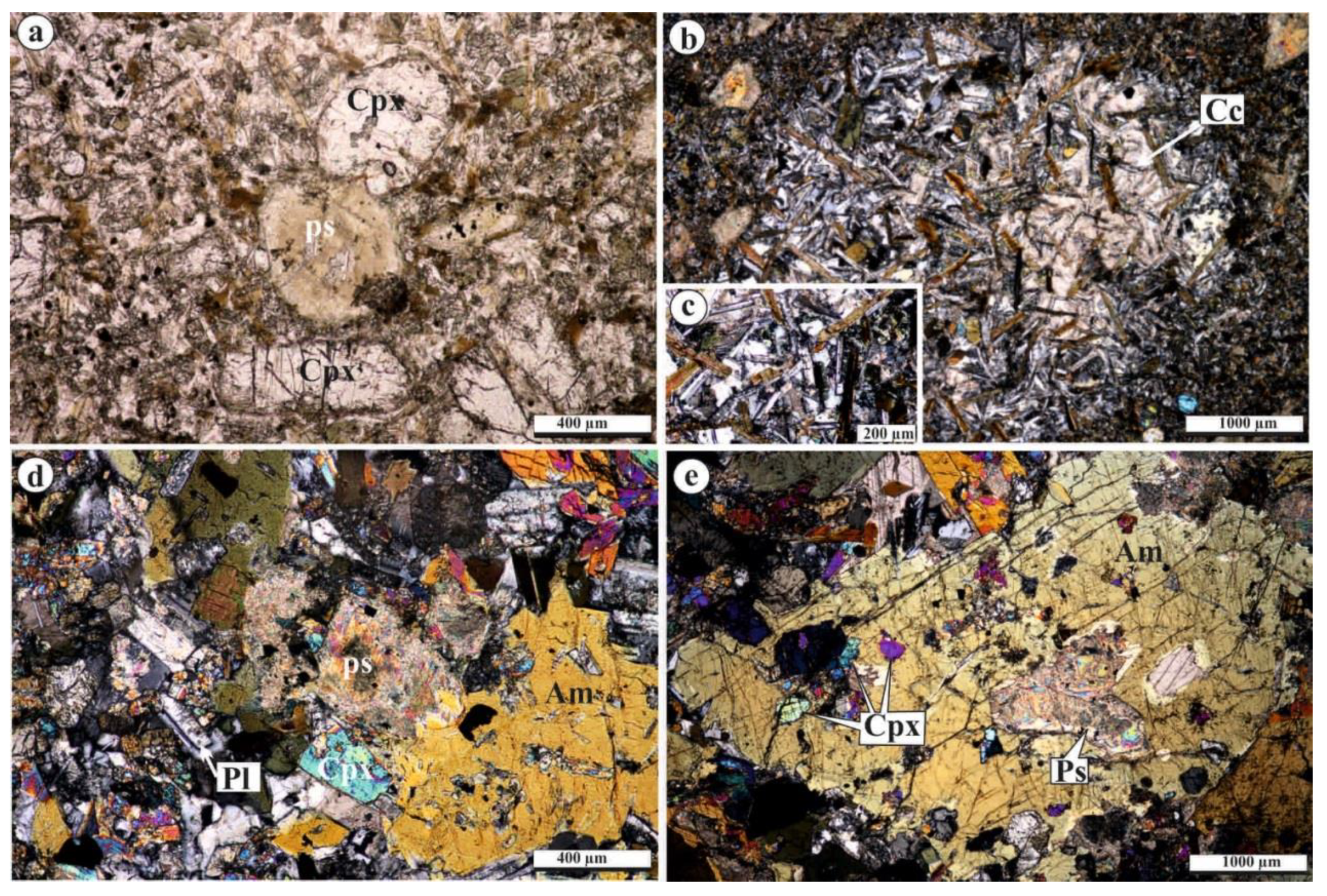
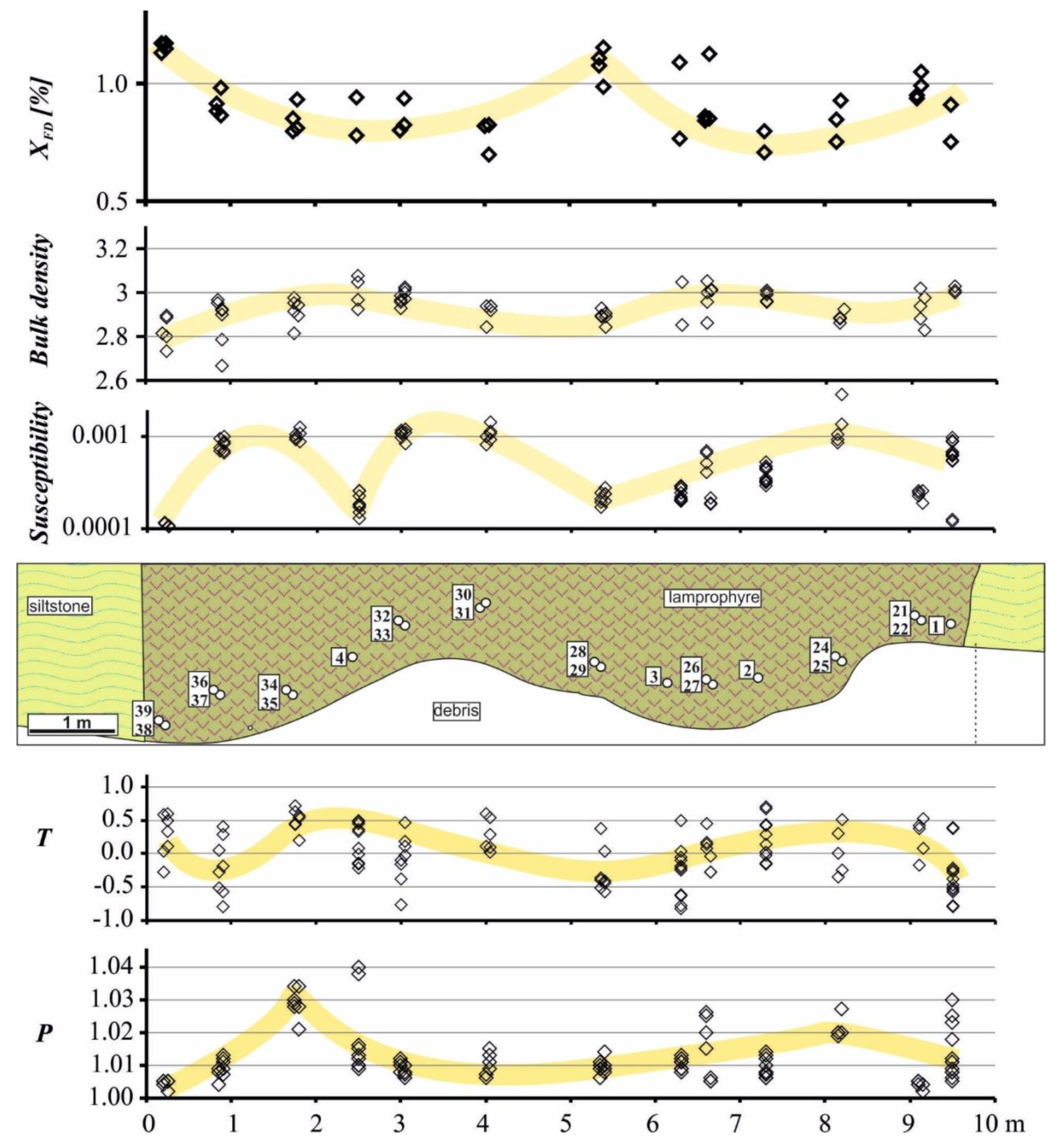

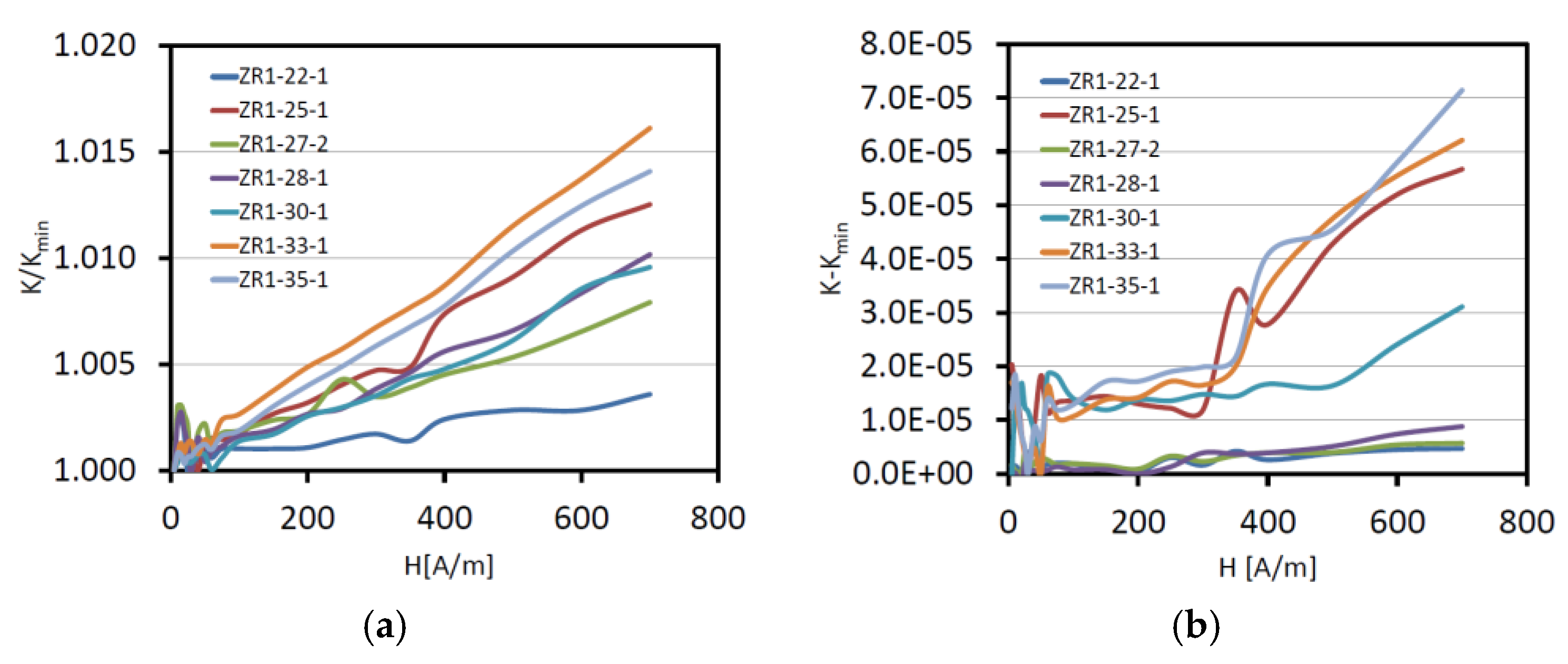


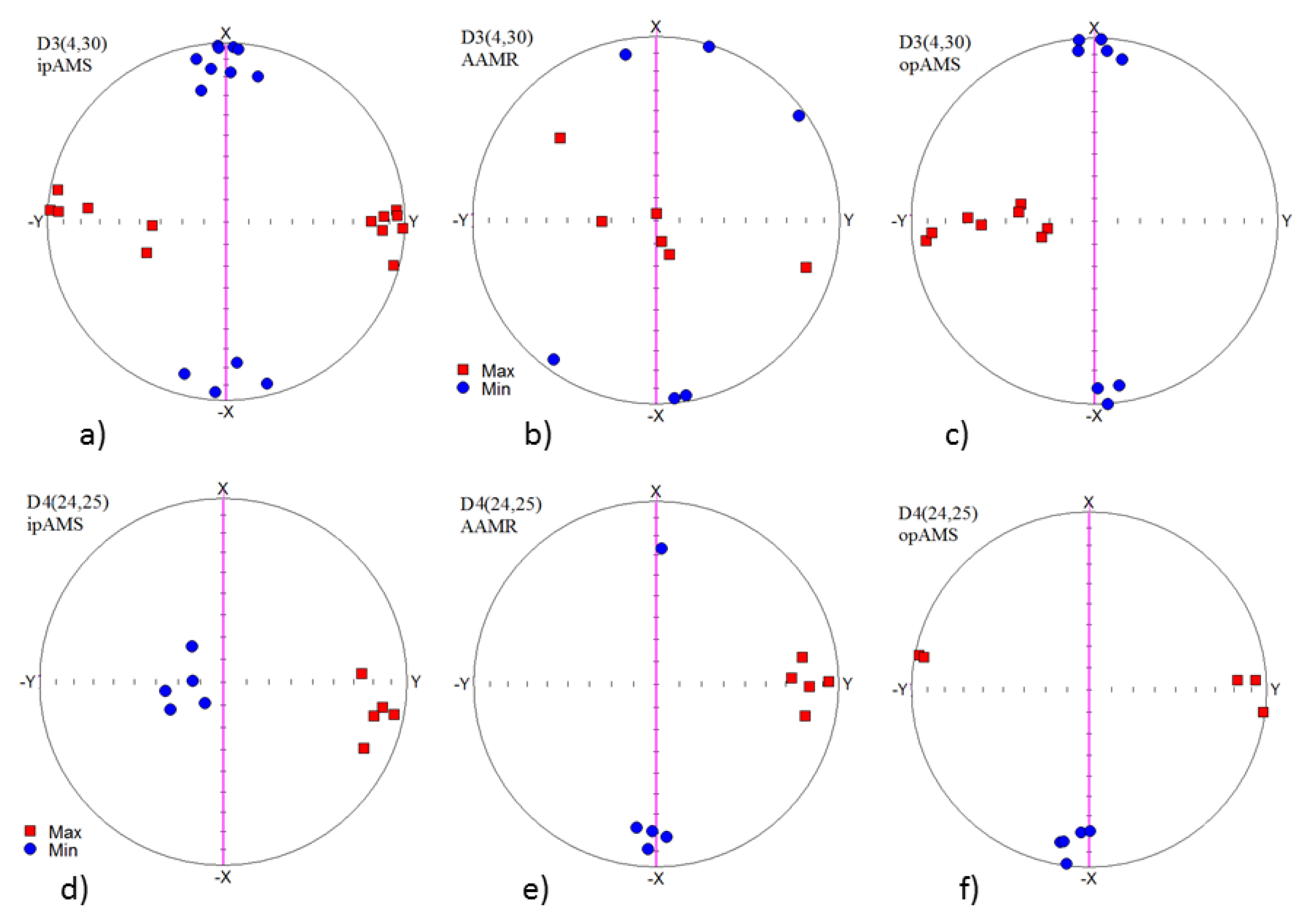

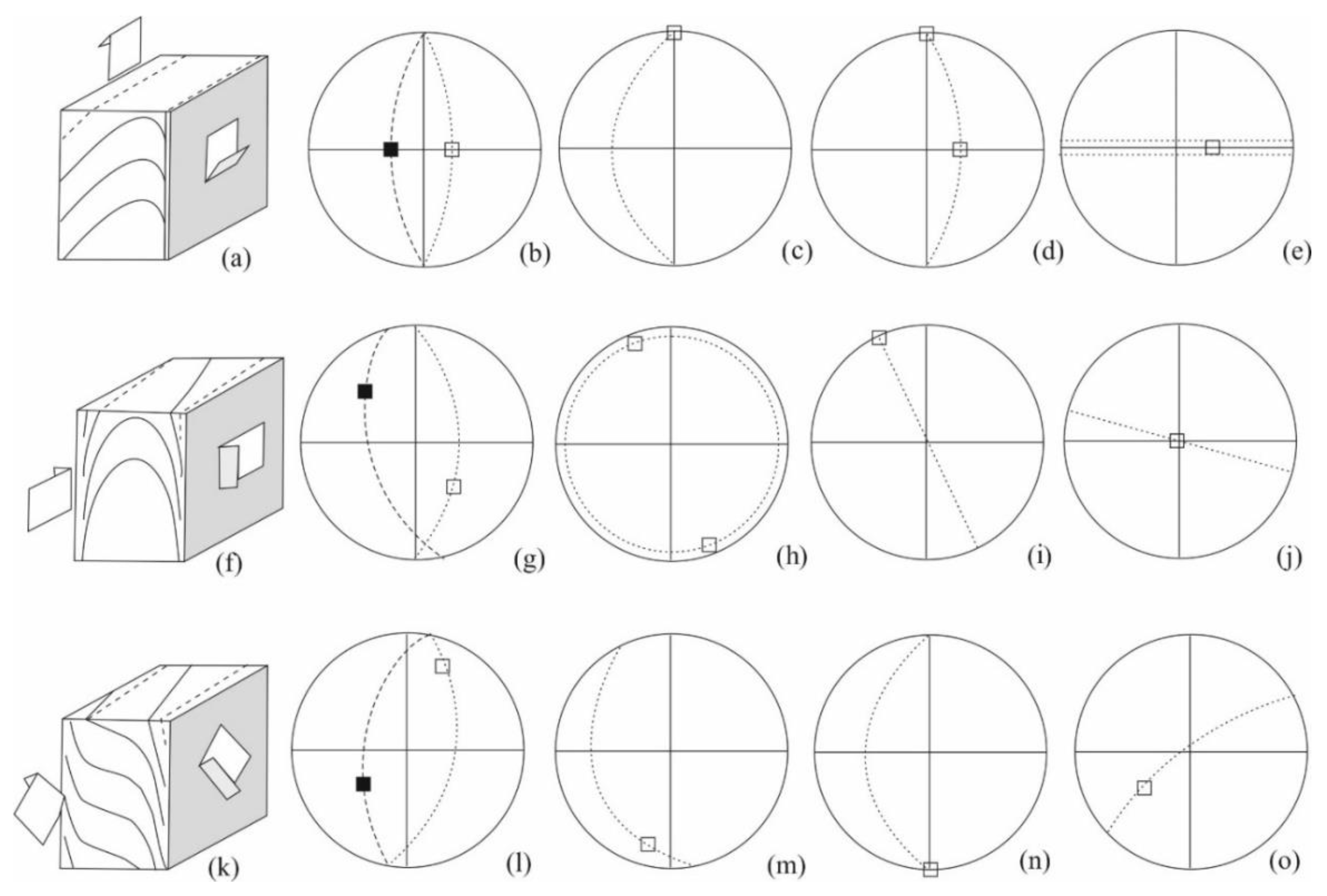

| Sample | LR 1123 | LR 1145 | LR 1113 |
|---|---|---|---|
| Rock | kersantite | spessartite | hornblendite |
| SiO2 | 48.05 | 50.31 | 45.78 |
| TiO2 | 0.55 | 0.71 | 0.51 |
| Al2O3 | 12.46 | 15.43 | 9.72 |
| Fe2O3* | 9.76 | 8.62 | 9.45 |
| MnO | 0.17 | 0.15 | 0.16 |
| MgO | 11.65 | 9.25 | 15.46 |
| CaO | 9.94 | 8.31 | 12.21 |
| Na2O | 1.27 | 2.66 | 0.87 |
| K2O | 1.57 | 0.92 | 0.89 |
| P2O5 | 0.28 | 0.18 | 0.16 |
| LOI | 2.35 | 2.70 | 3.2 |
| Total | 98.05 | 99.24 | 99.41 |
© 2019 by the authors. Licensee MDPI, Basel, Switzerland. This article is an open access article distributed under the terms and conditions of the Creative Commons Attribution (CC BY) license (http://creativecommons.org/licenses/by/4.0/).
Share and Cite
Hrouda, F.; Faryad, S.W.; Kubínová, Š.; Verner, K.; Chlupáčová, M. Simultaneous Free Flow and Forcefully Driven Movement of Magma in Lamprophyre Dykes as Indicated by Magnetic Anisotropy: Case Study from the Central Bohemian Dyke Swarm, Czech Republic. Geosciences 2019, 9, 104. https://doi.org/10.3390/geosciences9030104
Hrouda F, Faryad SW, Kubínová Š, Verner K, Chlupáčová M. Simultaneous Free Flow and Forcefully Driven Movement of Magma in Lamprophyre Dykes as Indicated by Magnetic Anisotropy: Case Study from the Central Bohemian Dyke Swarm, Czech Republic. Geosciences. 2019; 9(3):104. https://doi.org/10.3390/geosciences9030104
Chicago/Turabian StyleHrouda, František, Shah W. Faryad, Šárka Kubínová, Kryštof Verner, and Marta Chlupáčová. 2019. "Simultaneous Free Flow and Forcefully Driven Movement of Magma in Lamprophyre Dykes as Indicated by Magnetic Anisotropy: Case Study from the Central Bohemian Dyke Swarm, Czech Republic" Geosciences 9, no. 3: 104. https://doi.org/10.3390/geosciences9030104




